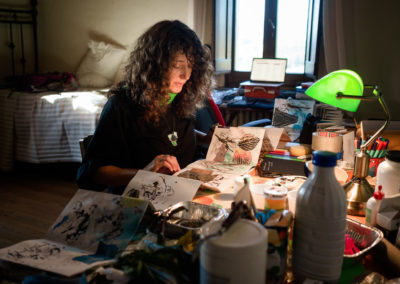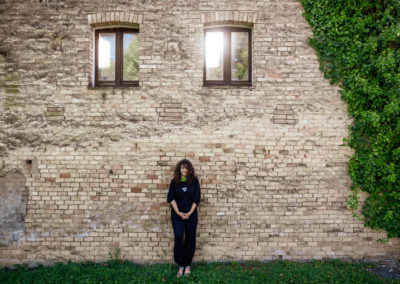Following on the heels of an intense academic year at Stanford, I arrived at Civitella Ranieri determined to send out a book proposal to publishers by the end of my stay for a study about dreams of a “wireless” transnational language titled “Poetry After Fascism: Barbarism, the Abracadabrant Word, and the Invention of a Motherless Tongue.” The headlines were raging upon our landing in Umbria with the rise of populist leaders whom many would consider to be neo-Fascists, so the issues raised in the study were hardly confinable to history and theory. The charmed conditions at the castle and beyond deflected this rather limiting task of professional obligation. Instead of producing a formulaic document for editors, I spent my time plumbing the deeper implications of the writing and art at the heart of my study, starting a conversation with M’barek Bouhchichi, my neighbor from Morocco, about the poetry of Iraqi author Badr Shakir al-Sayyab, a dialogue with Masha Gessen, my neighbor from Russia, about the ways in which work with heritage languages, while intellectually devalued, enriches experience, and a conversation with Anne Kreamer, my neighbor from New York, about non-human language and cognition. I simultaneously struck up an oblique dialogue with one of my life’s mentors, the Lebanese American artist Etel Adnan, starting to paint panoramic poems in accordion books, as she’d encouraged me to do for years; a dialogue with my new friend from Amsterdam, the musician and composer Anne La Berge, about the uses of obsolescing media in poetry and music, which we hope will end in a collaboration; and a dialogue with my new friend from Tanzania, the photographer and filmmaker Nicholas Calvin Mwakatobe, about new forms of publishing poetry that shuttles across visual, aural, and textual inquiry, which ended in production of a short collaborative film. Dana Prescott’s workshop on egg tempera and our trip to the stained glass workshop of Studio Moretti were other precious highlights enabling us to connect the materiality of art with its spiritual cravings. These conversations crossing from literary into visual, spatial, and aural spheres—conversations that have not been halted by the residency’s end, as our group of Fellows continues to be in fond contact with one another—made for continual fire; the new forms of inquiry they jumpstarted for me in accordion books, video, and digital media will be ongoing for years to come. Many of us took time in the mornings—cleared, as if by miracle, for thinking—to explore the ecstatic architecture of the castle and the landscape of tobacco and sunflower fields in the Upper Tiber Valley in which it sits. Roving like that, freed from immediate obligations, and nourished by geniuses in the kitchen and in fresco, inspires risk, while over the course of six immaculate weeks allowing an exhilarated person to distill ideas to their essences. I will cherish my time at Civitella Ranieri forever.
Related News Posts



